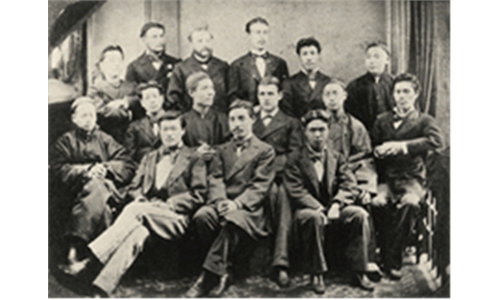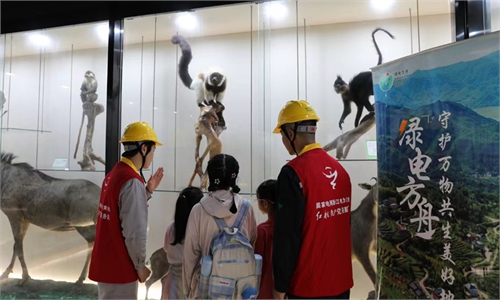ARTS / CULTURE & LEISURE
Interdisciplinary studies boost innovative research, training
In late June, Beijing Forestry University (BFU), a university which has earned a good reputation for its natural science subjects such as forest engineering and biology, launched a new groundbreaking center dedicated to Environmental Art (EA).

Why would an atypical art-oriented university dedicate an entire facility to bridging the sciences and arts?
The answer to this question lies in a growing educational trend: More and more Chinese universities now value the implementation of interdisciplinary research.
Taking BFU's EA major. It scrutinizes research paths like "carbon-neutral landscapes and public arts." The course is rather niche, and Feng Ke, a public arts researcher, told the Global Times that he believes it will merge knowledge of "ecology, fine art sculpture and sustainable development."
Institutional cross-disciplinary education is complex since binding the "ecology with the fine arts" do not mean putting art student A and ecological student B in one class, but rather cultivating talent equipped with both artistic and ecological knowledge. In other words, a university's interdisciplinary center needs to develop new teaching systems and tailored curriculums to serve multi-talented students. Such dedicated designs can already be found at Chinese colleges like Tianjin University.
In 2022, China launched its first master's degree in interdisciplinary Intangible Cultural Heritage research at Tianjin University. Guo Ping, the school's teaching and research department director, told the Global Times that, to cultivate all-round talents, the school has designed its own textbooks and curriculum that incorporates subjects like Chinese folklore study, anthropology and cultural law and policy.
Developing a cross-subject research facility takes effort and requires investment in money and teaching resources. However, such challenges have not stopped Chinese universities from continually promoting their interdisciplinary agendas, especially in the past five years.
In addition to BFU and Tianjin University, Beijing Normal University founded the Future Design School in 2021 on its Zhuhai campus, in South China's Guangdong Province.
By merging design, education and technology, the new institution trains talents who can propose pragmatic solutions and plans to local innovative companies located in the Guangdong-Hong Kong-Macao Greater Bay Area.
If a university organ can guide a student to launch creative projects that engage multi-sided knowledge and their studies can be utilized in social organizations, then a school's interdisciplinary agenda should not be just credited as an "educational success," but instead should be hailed as a farsighted strategy serving social progress.
"Innovative technology contributes significantly to boosting China's new quality productive forces, while the sector of education can make such power sustainable," cultural sociologist Xu Shuming told the Global Times.
Take the study of architecture. While the subject is considered both social science and natural science-oriented in Western education systems, architectural education in China is more commonly seen as a "rational" subject that prioritize skills over cultural narratives.
Encouraged by the growing cross-field research ambiance in China, researchers of the subject now developed new theories such as "Chinese philosophy and architecture," which make the study more comprehensive in considering both questions of "How to build a building?" and "Why is a building built?"
The author is a reporter with the Global Times. life@globaltimes.com.cn

Illustration: VCG
Although the field of EA engages several natural science traditions, its spirit of exploring the dualism of "nature and humanity" seems to connect it more closely with the liberal arts such as sociology, fine art practices and philosophy.Why would an atypical art-oriented university dedicate an entire facility to bridging the sciences and arts?
The answer to this question lies in a growing educational trend: More and more Chinese universities now value the implementation of interdisciplinary research.
Taking BFU's EA major. It scrutinizes research paths like "carbon-neutral landscapes and public arts." The course is rather niche, and Feng Ke, a public arts researcher, told the Global Times that he believes it will merge knowledge of "ecology, fine art sculpture and sustainable development."
Institutional cross-disciplinary education is complex since binding the "ecology with the fine arts" do not mean putting art student A and ecological student B in one class, but rather cultivating talent equipped with both artistic and ecological knowledge. In other words, a university's interdisciplinary center needs to develop new teaching systems and tailored curriculums to serve multi-talented students. Such dedicated designs can already be found at Chinese colleges like Tianjin University.
In 2022, China launched its first master's degree in interdisciplinary Intangible Cultural Heritage research at Tianjin University. Guo Ping, the school's teaching and research department director, told the Global Times that, to cultivate all-round talents, the school has designed its own textbooks and curriculum that incorporates subjects like Chinese folklore study, anthropology and cultural law and policy.
Developing a cross-subject research facility takes effort and requires investment in money and teaching resources. However, such challenges have not stopped Chinese universities from continually promoting their interdisciplinary agendas, especially in the past five years.
In addition to BFU and Tianjin University, Beijing Normal University founded the Future Design School in 2021 on its Zhuhai campus, in South China's Guangdong Province.
By merging design, education and technology, the new institution trains talents who can propose pragmatic solutions and plans to local innovative companies located in the Guangdong-Hong Kong-Macao Greater Bay Area.
If a university organ can guide a student to launch creative projects that engage multi-sided knowledge and their studies can be utilized in social organizations, then a school's interdisciplinary agenda should not be just credited as an "educational success," but instead should be hailed as a farsighted strategy serving social progress.
"Innovative technology contributes significantly to boosting China's new quality productive forces, while the sector of education can make such power sustainable," cultural sociologist Xu Shuming told the Global Times.
Take the study of architecture. While the subject is considered both social science and natural science-oriented in Western education systems, architectural education in China is more commonly seen as a "rational" subject that prioritize skills over cultural narratives.
Encouraged by the growing cross-field research ambiance in China, researchers of the subject now developed new theories such as "Chinese philosophy and architecture," which make the study more comprehensive in considering both questions of "How to build a building?" and "Why is a building built?"
The author is a reporter with the Global Times. life@globaltimes.com.cn



